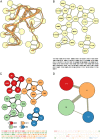Maps of random walks on complex networks reveal community structure
- PMID: 18216267
- PMCID: PMC2234100
- DOI: 10.1073/pnas.0706851105
Maps of random walks on complex networks reveal community structure
Abstract
To comprehend the multipartite organization of large-scale biological and social systems, we introduce an information theoretic approach that reveals community structure in weighted and directed networks. We use the probability flow of random walks on a network as a proxy for information flows in the real system and decompose the network into modules by compressing a description of the probability flow. The result is a map that both simplifies and highlights the regularities in the structure and their relationships. We illustrate the method by making a map of scientific communication as captured in the citation patterns of >6,000 journals. We discover a multicentric organization with fields that vary dramatically in size and degree of integration into the network of science. Along the backbone of the network-including physics, chemistry, molecular biology, and medicine-information flows bidirectionally, but the map reveals a directional pattern of citation from the applied fields to the basic sciences.
Conflict of interest statement
The authors declare no conflict of interest.
Figures




References
-
- Newman MEJ. SIAM Review. 2003;45:167–256.
-
- Newman MEJ, Barabási AL, Watts DJ. The Structure and Dynamics of Networks. Princeton, NJ: Princeton Univ Press; 2006.
-
- Palla G, Derényi I, Farkas I, Vicsek T. Nature. 2005;435:814–818. - PubMed
Publication types
MeSH terms
Grants and funding
LinkOut - more resources
Full Text Sources
Other Literature Sources
Medical

